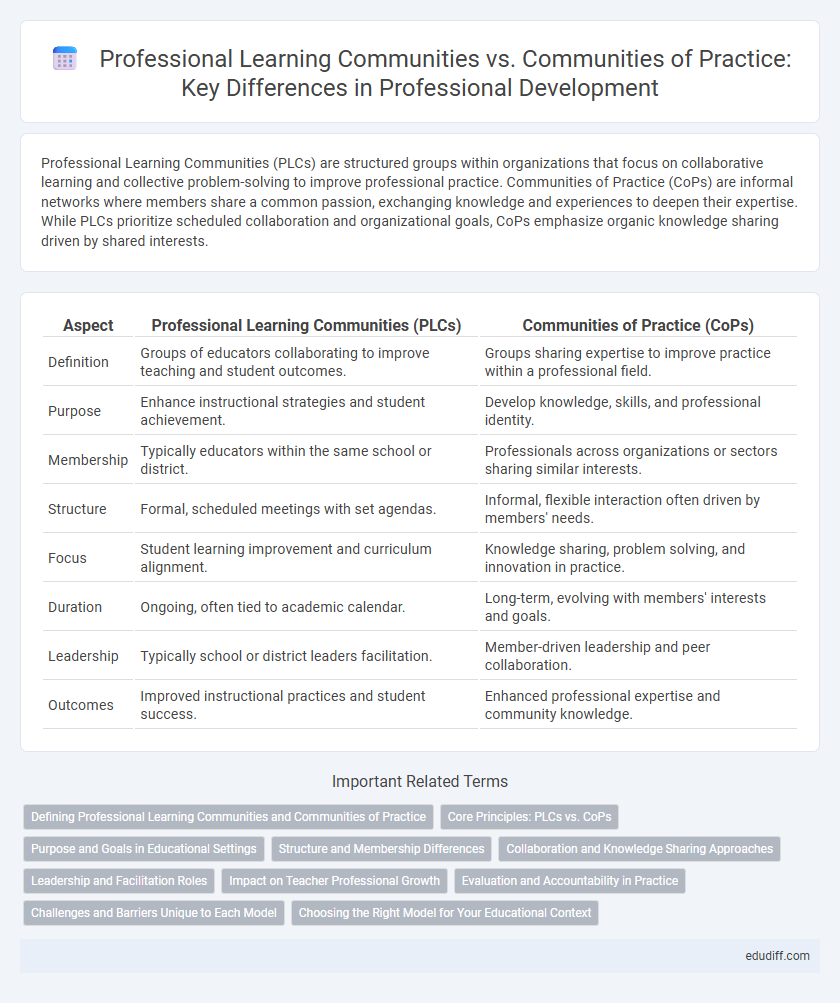Professional Learning Communities (PLCs) are structured groups within organizations that focus on collaborative learning and collective problem-solving to improve professional practice. Communities of Practice (CoPs) are informal networks where members share a common passion, exchanging knowledge and experiences to deepen their expertise. While PLCs prioritize scheduled collaboration and organizational goals, CoPs emphasize organic knowledge sharing driven by shared interests.
Table of Comparison
| Aspect | Professional Learning Communities (PLCs) | Communities of Practice (CoPs) |
|---|---|---|
| Definition | Groups of educators collaborating to improve teaching and student outcomes. | Groups sharing expertise to improve practice within a professional field. |
| Purpose | Enhance instructional strategies and student achievement. | Develop knowledge, skills, and professional identity. |
| Membership | Typically educators within the same school or district. | Professionals across organizations or sectors sharing similar interests. |
| Structure | Formal, scheduled meetings with set agendas. | Informal, flexible interaction often driven by members' needs. |
| Focus | Student learning improvement and curriculum alignment. | Knowledge sharing, problem solving, and innovation in practice. |
| Duration | Ongoing, often tied to academic calendar. | Long-term, evolving with members' interests and goals. |
| Leadership | Typically school or district leaders facilitation. | Member-driven leadership and peer collaboration. |
| Outcomes | Improved instructional practices and student success. | Enhanced professional expertise and community knowledge. |
Defining Professional Learning Communities and Communities of Practice
Professional Learning Communities (PLCs) are structured groups of educators who collaborate regularly to improve teaching practices and student outcomes through shared goals and data-driven decision-making. Communities of Practice (CoPs) consist of individuals who share a common profession or passion, engaging in continuous knowledge exchange and collective learning based on shared experiences and expertise. Both PLCs and CoPs emphasize collaboration but differ in their formal structure and primary focus, with PLCs centered on school improvement and CoPs on professional identity and learning.
Core Principles: PLCs vs. CoPs
Professional Learning Communities (PLCs) emphasize collaborative learning among educators focused on student outcomes through shared goals, data-driven decision-making, and continuous improvement cycles. Communities of Practice (CoPs) center around collective knowledge sharing and identity-building within a domain, fostering innovation and expertise through sustained social interaction. The core principles of PLCs include structured collaboration and accountability for learning results, while CoPs prioritize voluntary participation and the evolution of shared practices and meanings.
Purpose and Goals in Educational Settings
Professional Learning Communities (PLCs) in educational settings focus on collaborative efforts to improve teaching strategies and student outcomes through continuous reflection and data-driven decision making. Communities of Practice (CoPs) emphasize shared expertise and mutual learning among educators to develop deep professional knowledge and innovative practices. Both frameworks aim to enhance educational quality but differ in their approach: PLCs target systemic school improvement, while CoPs center on building specialized professional identities and practices.
Structure and Membership Differences
Professional Learning Communities (PLCs) are typically structured around regular, school-based teams focused on student achievement and curriculum alignment, with membership usually limited to educators within the same institution. Communities of Practice (CoPs) feature a more flexible, self-organizing structure that spans across organizations and disciplines, attracting members who share a common professional interest or practice. The key structural difference lies in PLCs' formal, institution-centric setup versus CoPs' informal, interest-driven collaboration that crosses organizational boundaries.
Collaboration and Knowledge Sharing Approaches
Professional Learning Communities emphasize structured collaboration through regular, data-driven meetings aimed at improving teaching practices and student outcomes. Communities of Practice focus on informal, interest-driven knowledge sharing where members collectively develop expertise through ongoing dialogue and shared experiences. Both approaches foster collaboration but differ in their levels of formality and mechanisms for knowledge exchange.
Leadership and Facilitation Roles
Professional Learning Communities (PLCs) emphasize collaborative leadership where facilitators coordinate shared goals, data-driven decision-making, and reflective practices to enhance collective teacher efficacy. Communities of Practice (CoPs) rely on distributed leadership, with members rotating facilitation roles to foster knowledge sharing, innovation, and sustained engagement within their domain expertise. Effective leadership in PLCs is more structured and goal-oriented, while facilitation in CoPs is emergent, promoting peer-driven learning and autonomy.
Impact on Teacher Professional Growth
Professional Learning Communities (PLCs) foster structured collaboration among educators through regular meetings, shared goals, and data-driven instruction, directly enhancing teacher professional growth by promoting reflective practices and accountability. Communities of Practice (CoPs) emphasize informal, organically developed peer interactions centered on shared interests, driving professional growth through knowledge exchange and social learning. The impact of PLCs tends to be more measurable and systemic, while CoPs contribute to deeper, intrinsic motivation and sustained teacher development.
Evaluation and Accountability in Practice
Professional Learning Communities (PLCs) emphasize structured evaluation metrics such as student outcomes and instructional effectiveness to drive continuous improvement, ensuring accountability through regular data analysis and collaborative reflection. Communities of Practice (CoPs) prioritize shared expertise and peer feedback, fostering accountability by promoting collective responsibility and ongoing professional dialogue rather than formal assessments. Both models enhance educational practice but differ in evaluation approaches, with PLCs relying on measurable outcomes and CoPs on experiential learning and mutual support.
Challenges and Barriers Unique to Each Model
Professional Learning Communities (PLCs) face challenges such as time constraints, inconsistent participation, and difficulties in aligning goals across diverse educational roles. Communities of Practice (CoPs) often struggle with sustaining member engagement, balancing informal learning with organizational objectives, and managing varying levels of expertise among participants. Both models must address cultural resistance to collaboration and the need for ongoing facilitation to maintain momentum and achieve meaningful outcomes.
Choosing the Right Model for Your Educational Context
Professional Learning Communities (PLCs) emphasize collaborative reflection, data-driven instruction, and shared responsibility among educators to improve student outcomes, making them ideal for schools prioritizing consistent curriculum alignment. Communities of Practice (CoPs) center on informal knowledge sharing and expertise development around specific professional interests, suitable for educators seeking flexible, interest-driven collaboration. Selecting the right model depends on your educational goals: choose PLCs for structured team-based accountability or CoPs for dynamic, self-directed professional growth.
Professional Learning Communities vs Communities of Practice Infographic

 edudiff.com
edudiff.com